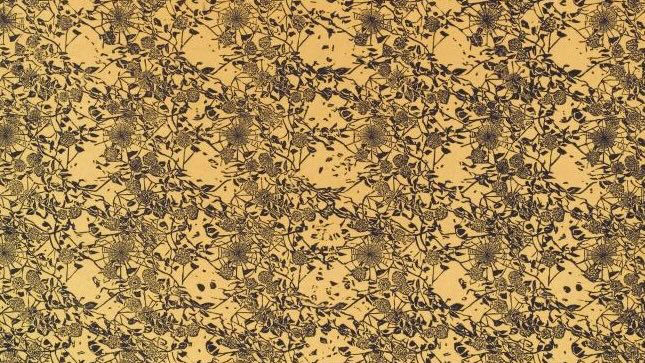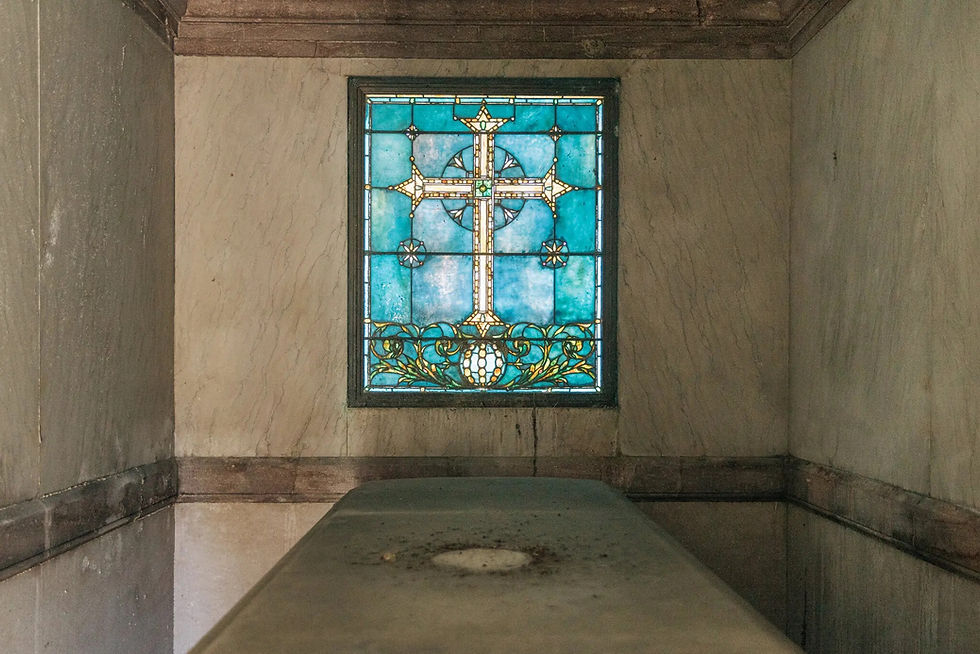
Tiffany in the Wild: Living Museum of Light and Memory
- Eduardo Montes-Bradley

- Sep 12
- 6 min read
Updated: Sep 16
Louis Comfort Tiffany’s opalescent glass windows are immersive experiences that transform light, space, and emotion. At Woodlawn Cemetery in New York, these masterworks remain in their original settings as ideal complements to the funeral architecture meant to represent the lifestyle of prominent families during the Gilded Age. These vitraux constitute a perfect example of “Tiffany in the Wild,” work to be appreciated in the environmental context for which it was intended. At Woodlawn, Tiffany’s windows still shift with sun and moonlight, creating spaces for reflection and revealing the collaborative artistry of the Gilded Age. As a living museum, the cemetery shows how death, beauty, and public space converge to form experiences that, like ancient funerary monuments, transcend personal memory and enter the realm of shared history and art. It is important to consider, however, that the windows we find at Woodlawn are not the sole testimony of this mortuary monument tradition. Tiffany windows can be found in cemeteries across the United States, and research is currently underway at the Colón Cemetery in Havana, a magnificent necropolis. While linked to architectural design and liturgical needs, Tiffany’s commissions for temples of the living (churches) and for the dead (mausoleums) differ in several aspects. These distinctions are best addressed by experts such as Brianne Van Vorst of Liberty Stained Glass Conservation and Alice Cooney Frelinghuysen and Drew Anderson from the Metropolitan Museum of Art, who will be consulted for this film.

Death Reimagined as Public Recreation
The transformation of American burial grounds began in the 1830s with the rural cemetery movement, pioneered by Mount Auburn Cemetery (1831) in Cambridge, Massachusetts. This shift responded to unsanitary conditions in overcrowded cities shaped by a new wave of immigration that would permanently alter the urban landscape. Established in 1863, Woodlawn embodied the vision of cemeteries as expansive, park-like settings serving multiple civic purposes. Until quite recently—and in some cases even today—visiting deceased relatives was part of the Sunday mise-en-scène, alongside worship and the gathering of the living around the family table. Victorian society discovered that contemplating mortality in beautiful settings could be both morally improving and recreational, and Woodlawn played a pioneering role in the perception of cemeteries as public parks where picnicking along tree-lined carriage roads, attending outdoor concerts, and gardening were part of the social fabric, rituals that crossed class divisions and reflected enduring European traditions.
Art, Memory, and Collaborative Genius
American funeral culture, with its emphasis on elaborate rituals, inspired the Gilded Age mausoleum boom. Magnificent memorials were erected as permanent monuments to family legacy and artistic patronage. At Woodlawn, this new ideal invited America’s leading architects to design structures rivaling contemporary civic landmarks representing the pinnacle of Beaux-Arts collaborative artistry. Architectural firms such as McKim, Mead & White and Carrère & Hastings worked directly with Tiffany Studios from the design phase, ensuring that windows complemented the overall architectural vision. When this collaboration extended to sculptors like Daniel Chester French or Attilio Piccirilli on a single memorial, it represented the fullest integration of the decorative arts. In these mausoleums, excellence was distilled into intimate, jewel-like structures where light, glass, and sculpture were orchestrated with a precision rarely possible in larger commissions.
Beyond Woodlawn, Tiffany’s funerary art extended into other cemeteries across the nation. Green-Wood Cemetery in Brooklyn houses the Daly Mausoleum with its rare Tiffany window. Chicago’s Rosehill Cemetery contains a community mausoleum with numerous Tiffany windows. Cleveland’s Lake View Cemetery preserves the Wade Memorial Chapel, an extraordinary complete interior by Tiffany Studios. (1) Particularly striking are the three glorious Tiffany windows at the Lewis Ginter Mausoleum in Hollywood Cemetery, Richmond, Virginia, which remain among the finest examples of Tiffany funerary glass. Additional commissions can be found in Knollwood Cemetery in Ohio, Allegheny Cemetery in Pittsburgh, and historic mausolea in Bridgeport and Arlington, where Tiffany’s artistry transformed spaces of mourning into spaces of beauty. These examples confirm that Tiffany’s genius for funerary art was not confined to one location but spread across the country, each site integrating glass, architecture, and memory in unique ways.
Shared Beauty
The creation of Woodlawn’s Tiffany windows involved the active participation of the patrons for whom these monuments were built. These Gilded Age elites were not passive clients but co-creators, commissioning works that reflected their personal values, spiritual beliefs, and desires for lasting legacy. Their choices—specific designs, symbolic motifs like lilies or roses, and the interplay of light and stone—shaped mausoleums that were both personal sanctuaries and public art. This complicity ensured the windows were not mere decorations but integral to the emotional and spiritual experience, transforming private grief into shared beauty. For modern visitors, stepping into these spaces feels like entering a dialogue with these patrons, whose vision continues to resonate through the radiant glass.
The Women and Men Behind the Glass
Tiffany’s vision was executed by master artisans, including Clara Driscoll, whose botanical expertise shaped intricate designs, and Arthur J. Nash, whose innovative glass chemistry created the distinctive opalescent effects that made Tiffany Studios legendary. The Belmont Mausoleum, designed by Carrère & Hastings, features a Tiffany window with serene lilies set against sky-blue opalescent glass, symbolizing eternal peace. The window’s azure and amber hues bathe the Gothic stonework in light, transforming the space into a sacred chapel. In the Woolworth Mausoleum, a luminous composition of rose and emerald glass with intricate floral composition transforms as natural light moves across, evoking luminous vitality. The Gould Mausoleum, designed by McKim, Mead & White, showcases a window with restored lead cames and opalescent glass, its weather-resistant design preserving the vibrant interplay of light and color. These examples highlight how Tiffany Studios integrated artistic vision with technical precision, creating works that remain vibrant and evocative.
Woodlawn as Living Museum
Woodlawn’s windows embody the ideal concept for “Tiffany in the Wild” where Tiffany’s work is preserved in its original settings, still performing their intended function of transforming the visitor’s experience through colored light. Guided tours by the Woodlawn Conservancy allow the public to step inside these memorials to experience the light filtering across the cold marble and our physical presence, creating a profound sensory impact. The dynamic quality of these windows is ideal for documentary filmmaking. Placing cameras inside mausoleums to capture light shifting over a day—from soft morning hues to vibrant afternoon jewel tones, through seasons, rain, snow, and even moonlight’s poetic glow on interior marble—reveals their living nature. At night, moonlight through the glass splashes soft, silvery patterns, transforming the space into a dreamlike chapel, a visual poetry that echoes the patrons’ original vision.
The Paradox of Vitality Among Death
Visitors bathed in amber, rose, and azure light experience a transformative paradox: spaces designed for mourning radiate beauty and vitality. Faces glow with reflected color, bodies become luminous, creating an almost miraculous sense of life in a space otherwise consecrated to death. This reflects Tiffany’s genius and the Victorian understanding of memorial art—not somber, but transfiguring, where grief and beauty coexist in healing, restorative ways, fulfilling the patrons’ intent.
Conclusion: Light as Living Legacy
Tiffany in the Wild, an ambitious documentary project, seeks to portray the works of Louis Comfort Tiffany as they were meant to be appreciated—in the spaces for which they were created. Woodlawn Cemetery, with its remarkable collection of Tiffany windows, anchors the film as a living museum where art and memory continue to converge. By preserving the original relationships between patron vision, architectural context, and artistic execution, these works provide immersive experiences that no museum setting can replicate. Clara Driscoll’s designs, Arthur Nash’s glass chemistry, and Tiffany’s environmental vision, combined with the patrons’ participation, created environments where light itself shapes perception. The film not only offers audiences the joy of rediscovering Tiffany’s art in context but will also serve as a vital resource for academics and educators seeking to illustrate the enduring power of the decorative arts.
(1) Other cemeteries with Tiffany windows to consider:
Rosehill Cemetery, Community Mausoleum (Chicago, IL) — numerous Tiffany windows.
Knollwood Cemetery & Mausoleum (Mayfield Heights, OH) — collection of ~17 Tiffany windows.
Lake View Cemetery – Wade Memorial Chapel (Cleveland, OH) — full interior by Tiffany Studios, including the Flight of Souls.
Hollywood Cemetery – Lewis Ginter Mausoleum (Richmond, VA) — three Tiffany windows.
Abbey Mausoleum (Arlington, VA, former) — Tiffany windows rescued before demolition, now installed at Westover Library and MOCA Arlington.
Allegheny Cemetery – Chalfant Mausoleum (Pittsburgh, PA) — Tiffany Studios design, original window later stolen.
Green-Wood Cemetery – Daly Mausoleum (Brooklyn, NY).
Mountain Grove Cemetery – Mary E. Wright-Smith Mausoleum (Bridgeport, CT, historic, demolished).








Comments